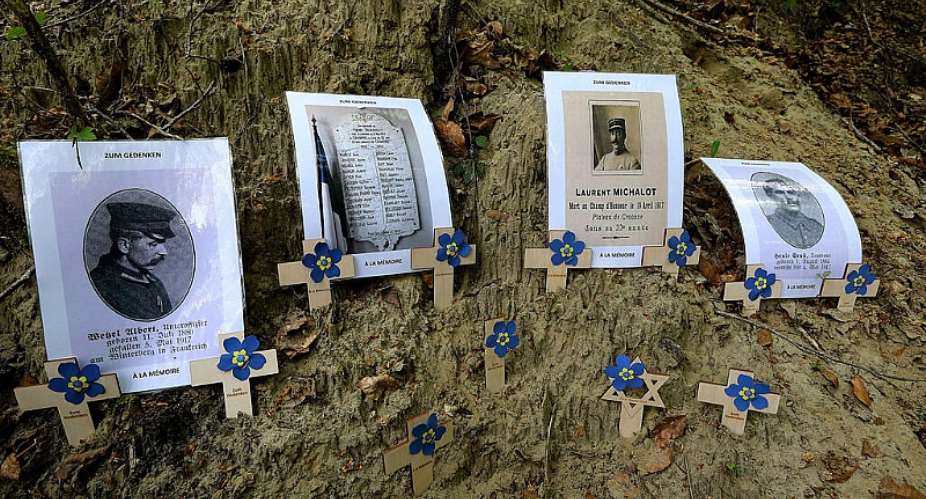German and French authorities are debating what to do with a “forgotten mass grave” of German soldiers who perished in a tunnel that was sealed by enemy forces in north-eastern France during World War I.
Following a drilling operation last week in the department of Aisne, experts were able to confirm the discovery of the so-called Winterberg Tunnel, which is believed to contain the bodies of some 270 German troops.
The German War Graves Commission (VDK) said a camera had been inserted into a large, dusty limestone cavity found deep in the ground, but that poor visibility prevented any clear images from being taken.
The VDK said future access to the grave – which is in the forest of Craonne and has been overgrown with vegetation – would only be possible through the use of heavy machinery.
The objective of the operation, the commission added, had not been to exhume any bodies but to study the site, while ensuring “due respect for the soldiers' remains”.
During the drilling, strict safety protocols were put in place to avoid setting off buried munitions. The drilled borehole was also carefully sealed.
Remembrance
Authorities in Aisne said the future of the "highly symbolic" tomb would be discussed by France and Germany with a “shared view to maintaining the memory of this tragic episode of the First World War”.
The two countries are considering making the Winterberg Tunnel a place of common memory in line with the Treaty of Aachen, which resolved to create new places of remembrance for Franco-German confrontations.
The German soldiers, of the 111th Reserve Infantry Regiment, from the Baden region, were killed in early May 1917 in one of several famous battles of the Chemin des Dames.
French artillery shells exploded a German ammunition depot inside the tunnel – which had been dug by the Germans and was used as their shelter – causing it to collapse on them.
- France publishes long-lost novel by Nazi collaborator Céline
- Century-old WWI carrier pigeon message discovered in French field
Those who were not killed instantly suffocated or died of anger and thirst in the days that followed, while others committed suicide. Two soldiers managed to escape.
In the century that followed the war, little interest was shown in locating the Winterberg Tunnel, with authorities only agreeing to officially investigate after pressure from a French amateur archaeologist and his son – who discovered the site.
After carrying out an exhaustive search of the forest, Alain and Pierre Malinowski in 2020 unearthed war relics including strips of uniforms, shoulder boards and a pocket mirror with a portrait of Emperor Wilhelm II.
Not everyone is happy with the find, however, with some archaeologists and war historians arguing the mass grave should have been left to history.





 Whoever participated in the plunder of the state must be held accountable – Jane...
Whoever participated in the plunder of the state must be held accountable – Jane...
 A vote for John and Jane is a vote to pull Ghana from the precipice of destructi...
A vote for John and Jane is a vote to pull Ghana from the precipice of destructi...
 I’ll repay your abiding confidence with loyalty, understanding and a devotion to...
I’ll repay your abiding confidence with loyalty, understanding and a devotion to...
 ‘I’ve learnt deeply useful lessons for the future' — Serwaa Amihere breaks silen...
‘I’ve learnt deeply useful lessons for the future' — Serwaa Amihere breaks silen...
 I’m sorry for the embarrassment – Serwaa Amihere apologises for leaked sex video
I’m sorry for the embarrassment – Serwaa Amihere apologises for leaked sex video
 Dumsor: Matthew Opoku Prempeh not in charge of Energy sector – Minority
Dumsor: Matthew Opoku Prempeh not in charge of Energy sector – Minority
 Adu Boahen’s murder: Police arrest house help who was in possession of deceased’...
Adu Boahen’s murder: Police arrest house help who was in possession of deceased’...
 Akufo-Addo nominates Felicia Attipoe as Tema West MCE
Akufo-Addo nominates Felicia Attipoe as Tema West MCE
 Election 2024: I can't have someone I defeated twice as my successor – Akufo-Add...
Election 2024: I can't have someone I defeated twice as my successor – Akufo-Add...
